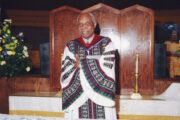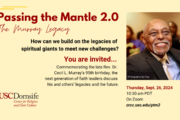CRCC Managing Director Brie Loskota wrote an op-ed for the Huffington Post reflecting on the 20th anniversary of the Rodney King beating.
Today marks an obscure but important milestone: the 20th anniversary of the Rodney King beating. The videotaped events of March 3, 1991, and the subsequent trial and acquittal of the LAPD officers, would set off the L.A. Riots more than a year later. For many faith leaders, especially those in South L.A., the period between the beating and the verdicts was a time of foreboding; a non-guilty verdict would mean disaster for their communities. Their worst fears were realized in April 1992 as the city fell into chaos.
Clergy, including L.A. heavyweights like Rev. Cecil L. Murray at First AME Church, took to the microphone, stood in front of the TV cameras and called for calm. He and others used their moral voice and standing within the community to remind us all that a shared outrage was not well-funneled into civil unrest.
In the ashes of that event, the city examined its racial divisions, its class lines and the major disparities that the riots shone their spotlight on. What resulted were efforts across religious, class, geography and racial lines for symbolic and short-term efforts to build bridges between those most impacted by the inequity in Los Angeles. Networks of cooperation emerged that brought people newly in to contact with each other to clean up the ashes, work on economic development and engage in dialogue across divisions.
In a new report on civil society and religion in L.A. from 1992-2010, my co-authors and I point out that these efforts not only helped the city move more closely together, but that they laid the groundwork for religious engagement in the public square in Los Angeles today. Though these efforts were largely short-lived, the relationships they nurtured and the ethos of religious engagement in L.A. most pressing issues have proved to have staying power.
Los Angeles is one of the most religiously diverse cities in the world, it is the largest gateway city for new immigrants and home to more than 200 languages. The city is also home to thousands and thousands of congregations and faith-based organizations.They meet in every possible venue from living rooms to several-thousand-person venues. And their approaches to engaging the world are equally diverse.
Some religious groups have opted out of the civic arena and focused on promoting individual health, prosperity and fulfillment. Others see the world as evil, broken and await a better day to come. But many see a religious mandate to act in the world to make it a better place for all, whether Jewish, Muslim, Christian, Buddhist, Hindu or a new religious movement. This type of religious engagement in the world bodes well for our ability to address the rifts and ruptures in our social fabric and fraying safety net.
The new challenges facing Los Angeles in the 21st century are perhaps less pressing than in those first few days in April 1992, but not less daunting. What the Rodney King beating, trial and verdict reminds us of today, is that the challenges of the last century have not gone away. Racism, class tension and the gap between the American dream and the urban reality highlight that we have far to go between the way things are and the way they ought to be. Today should also be a reminder that we should not wait for the next crisis to force us to know our neighbors, build our networks and envision a future where all can flourish. As they say in the disaster planning world, a crisis is a horrible time to be exchanging business cards.





